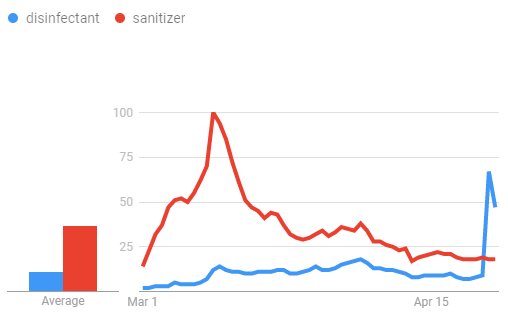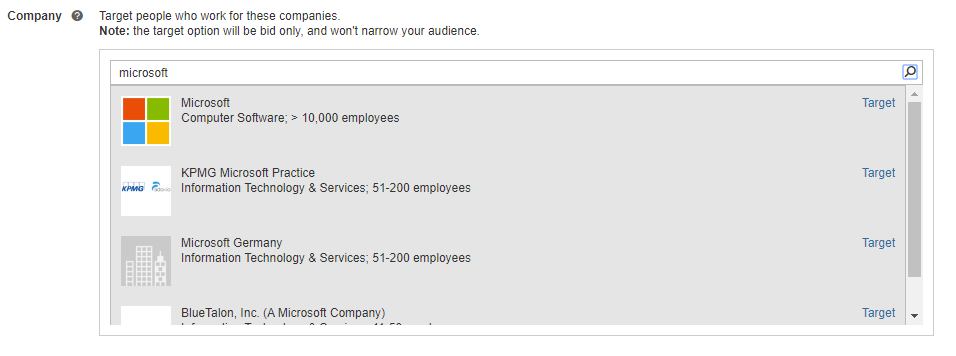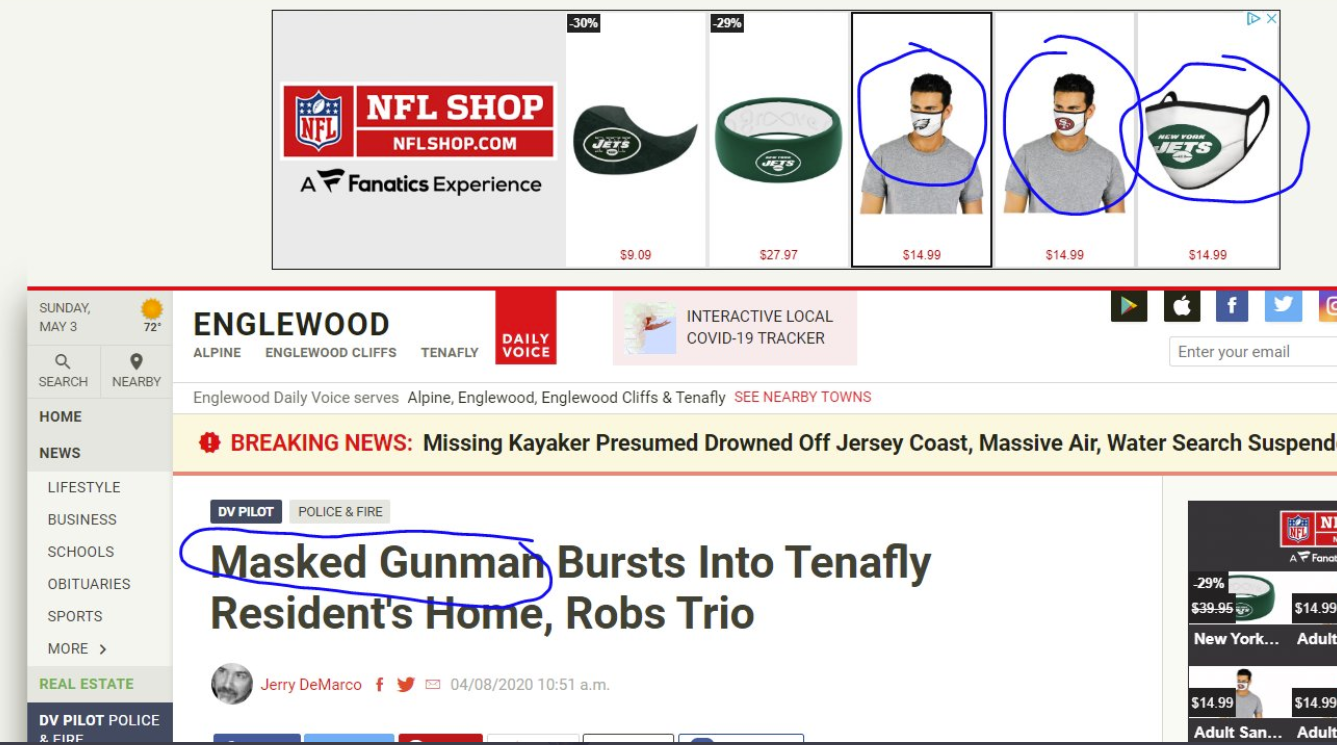Dearest fellow search marketer:
The world is a crazy place in early May 2020.
Pandemic, quarantine, stock market crashing, and the best thing on TV involves a tiger-owning, mulleted zookeeper from Oklahoma while plotting his rival’s murder (my popular opinion: Carol offed her husband and fed him to her tigers).
So yeah, things are a bit crazy, even in the search industry itself.
How crazy?
Well, the U.S. search marketing travel vertical was decimated in a matter of weeks:
 SEMrush Search traffic for a top U.S. OTA for the past 30 days
SEMrush Search traffic for a top U.S. OTA for the past 30 daysMeanwhile, it is becoming a golden age of search demand for healthcare, CPG…and items designed to wipe out germs:
 Google Trends data for 3/1-4/27 “Sanitizer vs Disinfectant”
Google Trends data for 3/1-4/27 “Sanitizer vs Disinfectant”Yes, for some, this scenario is worse than when Yahoo Overture migrated to Yahoo Panama and everyone’s billing information was exposed (old-time search joke there).
But the reality is, if you want to keep operating as a business, you need to get back into the market quickly, but with some degree of logic.
This is not a “flip the light switch back on and everything is unicorns and rainbows” scenario.
This must be thought out.
Carolyn Kagan, LCSW & Psychotherapist, of www.AllianceTherapyPractice.com, laid it out in perfectly captured phrase:
“Coming out of this situation is similar to veterans coming home from war, you need a plan for reentry.”
In other words, your old strategy may not work anymore.
You need to prepare and be ready to adjust.
Given that, let’s talk about the different courses of action you can take to reenter your ads back into the SERP.
You can move forward with one of three models:
- “Unfazed”: Pick right back up where you left off. Pretend we aren’t on the cusp of a recession, and try and pick up right where you left off.
- “Open the Floodgates”: Drown the market in investment, fill the top of the funnel as fast as you can. To have it pay out later, and recover your bottom of the funnel.
- “Profit First”: Conservatively return. Focus at the bottom of funnel, and week by week, expand upward, to maximize efficiency and ROI.
1. Unfazed
This model is simple. Somehow you came out of this relatively unscathed, or even ahead of the game.
This has been seen for healthcare and CPG advertisers.
Some competitors dropped out, you had to change your messaging but you didn’t take that big of a hit in revenue.
CPCs may have even improved for you.
So, for all intent purposes, you were unfazed by the scenario.
If you fall into this category, then, in reality, all you need to do is:
Update Messaging
Cautiously shift to a “You made it through, now it’s time to come and shop/sign up/explore” message.
Avoid messaging/message transition that leaves you sounding insensitive or tone-deaf (make sure a third party reviews the ads in this scenario).
Update Your Bids
Don’t reduce them on the non-brand side (if they were live the whole time).
If anything, start to push them up a bit and do it fast to build that high Quality Score.
Why?
Because once the competition comes back, CPCs will begin to rise, and it is easier for a bid strategy to reduce CPC and hold impression share than it is to control a CPC while trying to capture more impression share.
Budget
Maintain and/or return with your current budget but keep cash on hand if you need to incrementally scale.
As competition reenters, CPC will go up, and as people venture out, the need to buy more online due to shortages in store from the public returning to the outdoors may lead to an uptick in demand and therefore cost.
Double Down on Remarketing
If your site provides the need for repeat signups/purchases, then continue to lean into those consumers.
Nurture them with isolated messaging and deals, to retain them.
They are going to convert at a much better rate and at a greater frequency.
 GA New vs. Repeat Visitors
GA New vs. Repeat Visitors2. Open the Floodgates
From a business standpoint, the quarantine was a nightmare for you, not a worst-case scenario.
You are still technically in business, but it was bad.
Sales/leads plummeted, going hand in hand with demand.
You had to pull back, and while you might have saved some cash, you didn’t make up for it in return.
This hit all sorts of operations, including travel (nearly killed this industry outright), brick-and-mortar, and real estate to name a few.
The only way you envision recovery is big traffic, to get big returns, in a short period.
So you are going to flood your account with cash, to try and fully make up for the lost conversions by way of high traffic volume and high conversion rates (or so you hope).
This route isn’t for everyone, as it conflicts with more comfort levels (and is frequently hit by pure cash flow issues).
If you do wish to go this route, however, remember to do the following:
Brand Funding
Unless you are eBay or Amazon, there is rarely a reason not to fund your brand name first.
It is the cheapest and highest conversion rate.
Therefore, this is not the time to shortchange the investment in it.
Structure
If you’re relaunching in a gangbusters mentality, you don’t need to go the extreme of the SKAG model (which is more or less dead at this point), but it needs to be tight.
So what if you have 500 ad groups, you need the keyword relevance to ad copy to be tight.
Ad Copy Relevance
This is not the time to futz with ad copy that is generic or not addressing the query.
You’ve just restructured your ad groups to be tightly themed, so now is the time to make sure your ad copy is written especially for that ad group (do not be lazy and pull some DKI out for this).
Top of Funnel Audiences
Want to bid high on the high volume, short tail keywords?
Sure, go for it.
But for the love of God, don’t let the entire world see them.
Just the most qualified.
Now is the time for your lookalike/similar audiences to shine bright.
In Google Ads, lean heavy into those custom intent and in-market audiences, they will save you a penny here and there, and help with the searcher qualification.
In Bing Ads (because I can’t bring myself to regularly call them Microsoft Ads), lean heavily into the LinkedIn Profile Targeting, especially given the economy, you want to focus on those who are still in the right mindset (still making money) to serve your ads to.
 Microsoft Ads LinkedIn Targeting
Microsoft Ads LinkedIn Targeting3. Profit First
You and your company have likely had a rough go of the quarantine, both professionally and personally (I started having daily conversations with my Roomba, in addition to buying 5 chickens).
However, you were able to produce enough revenue during quarantine and/or had enough in the bank to be able to push forward.
There are pocket examples of this in nearly every vertical, as it came down to how you were managing your business prior to the pandemic.
Since you aren’t in the poorhouse, but you also don’t want to or can’t go crazy with spend, you’re planning for a more controlled and gradual return to the SERPs.
With the hopes and anticipation that if you pull in high enough profitability levels upfront on lower traffic volume, it will offset lower profitability as you scale traffic upward, over an extended period.
Just like the “Open the Floodgates” model, this isn’t for everyone. It is slower, more calculated, and more profitable.
But the sustainability at lower total return levels is rarely successful for a growing company in the long term.
If you do plan on going this route, besides making sure you have enough capital in the bank to get it in motion, and keep it in motion, you need to do the following:
Brand Funding
Day 1: Should be obvious, max out the funding here first.
I personally am not a huge fan of targeting impression share for a bid strategy. It depends on how much competition there is on your name.
I typically shoot for maximize clicks, to stretch the dollar out, but most importantly, make sure it is funded and ready to visible.
Non-Brand
Low Funnel
Day 1: Traffic coming to these long-tail/hyper-specific keywords are great. Depending on the cost, attempt to fund them at max levels, with audience layers in place (in market or lookalike/similar audiences to control the spend).
Week 2: Depending on efficiency, consider pulling off the audience layers to test it out to the wider crowd.
Mid Funnel
Week 2-4: Begin to roll out your mid-funnel keywords. Utilize heavy audience targeting.
Max out funding in these when the audience targeting is applied, until you hit an acceptable ROI (which doesn’t have to mean positive). Once you hit your predetermined level, attempt as scaling up spend.
Week 3-6: In standalone campaigns, begin to fund non-audience segmented mid-funnel keywords for the general audience to be able to trigger.
Using a tiered ROI approach, determine what spend levels you’re hitting acceptable return before you scale spend up.
Top of Funnel
Week 5-8: Begin funding the short tail/high volume top of the funnel keywords. Isolate their rotation heavily by device, time of day, and audience. Not everyone should be able to see your ads, only the most qualified.
Week 9+: If you’ve completed the prior timeline and steps, and seeing a good return at higher levels, then, in a standalone campaign, look to start funding top of funnel keywords without audiences. But don’t do it before completing the prior steps.
Targeting
Going beyond the audience targeting (which by now you must be an expert in), you must scrutinize every component of the data.
Determine what device is for research and which one is for converting. Knowing what time of day, day of week, and geography gets you the best output.
Then adjust your ad target and rotation accordingly.
The key to this approach is to be discriminating until profitable, before you expand outward.
Applicable to All Models
- Don’t forget, that the economic downturn caused by the pandemic is just beginning. If you’re driving sign-ups or sales, it’s imperative to run your “deals” and “cost savings” benefits. Consumers will be cautious with their dollars but will still need to spend it somewhere.
- We are heading into uncertain times. Therefore, do not use countdown ads! Nothing is less encouraging than reading an ad indicating that time is nearing the end.
- Lastly, I cannot stress this enough, if you use any GDN remarketing, and sell facemasks, please use appropriate contextual exclusions.
 When remarketing goes wrong.
When remarketing goes wrong.I know this is a tough time for the search business.
You’ll get through this.
But please be wise, you need to adjust your strategy, or you will take a negative hit in your business.
More Resources:
- 8 Things Advertisers Say They’re Doing During COVID-19
- When Clients Pause PPC: 5 Survival Tips for Marketers
- 5 Tips for Managing PPC During the Coronavirus Outbreak
Image Credits
All screenshots taken by author, May 2020





